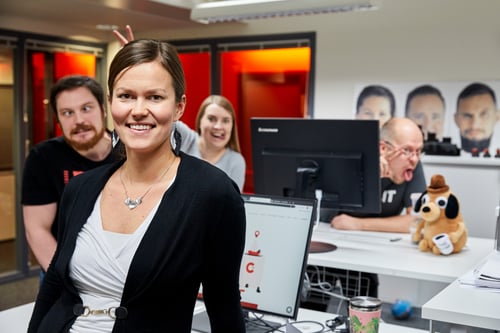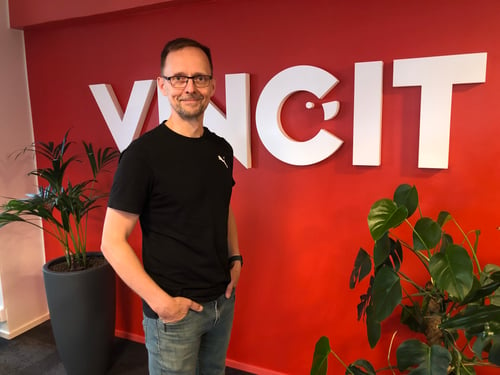Even though projects are carried out by teams, the project lead is ultimately responsible for making sure that everything works as it should for both the client and the employees. To put it differently, how a project is led affects not only the project itself, but the work community and clientele as a whole. This is something we want to invest in. We’re passionate about making sure that at Vincit, leading is done the Vincit way. This desire is what in the end, drove us to develop our project lead training ourselves, as a production organized by Vincitizens.
Our organization is community-driven, which means that being a project lead isn’t a separate role, but a rotating responsibility. Anyone can take the lead if they want to. Anyone can also participate in our project lead training, and many have indeed jumped at the opportunity: our project lead training has already been taken up by over 130 Vincitizens.
Having a Good Lead Improves the Quality of Work
I began planning the project lead program with the help of one of Vincit’s Business Directors, Laura Niittylä. Even though Laura’s main focus is on business, she also wants to be involved in the training of our Vincitizens. In our field, business and people development always go hand in hand.
– Developing our project lead training is something I’m particularly invested in, since it provides a key to preventing project-related problems and therefore has the potential to improve everyone’s well-being and quality of work. This is definitely a plus for both our clients and our employees, Laura explains.

– Our project lead training offers many learning points and new insights into how to carry out a successful project at Vincit. In addition, it encourages the participants to assume the role of a project lead and provides them with support so that the project yields a positive outcome, Laura describes as the objectives of the training.
To achieve our objectives, we approach project management from a variety of perspectives. We naturally spend a lot of time on agile development and client management, but we also discuss project fails and talk about who to contact to get help in various situations. We also place considerable emphasis on interaction. All in all, the way the content of the training is determined is indicative of what the organization considers important.
The Vincit Way
To get an idea of how Vincit handles things, consider the project lead training session aptly named, “When everything gets fucked up.” It discussed a real-life project that failed gloriously. The trainer for this challenging topic was one of our most experienced account executives, Ari Kontiainen.
– The good thing about failing is that it presents an amazing opportunity for learning, Ari says. He gives kudos to the project team, who courageously gave permission to discuss their project in the training.
Despite the screw-up, the service in question is still available today, and Vincit’s relationship with the client has grown into a success story. In other words, proper attention was also paid to aftercare, which proved essential to the development and continuation of the client relationship.

– In the training, we don’t only discuss the things that went wrong and why, but also how the entire thing could’ve been avoided. Although we don’t want anyone to screw up, preparedness for the eventuality of failure is important, as is being able to change course in time, Ari says.
We’ve aspired to make our project lead training as engaging as possible by emphasizing the role of group work.
– The lead training relies heavily on discussion. It’s a great way to provide peer support for anyone who’s ever screwed up. That’s all of us, by the way, Ari says, laughing.
Community-Driven
When a training program such as ours dives into a variety of topics, it’s impossible to find a trainer who’s an expert in all of them. It was clear from the beginning that each topic should have its own training session. This allowed us to select the best possible trainer for each theme. For example, the meetings related to interaction and teams are held by a solution-oriented coach, while our agile coaches take care of meetings that discuss the theory of agile development.
The advantage of having several trainers is that the responsibility is shared between the team and the organization of the entire program doesn’t fall on a single trainer. Consequently, each trainer needs to know the contents of the other training sessions in order to avoid unnecessary repetition, and this requires a great deal of coordination. Doing this part of the process properly pays off and provides an opportunity to share best practices within the organization.
Training Leads To Organizational Learning
At the end of the day, has developing our project lead training been worth all the trouble and coordination efforts? In my opinion, yes. Our decision to organize the training ourselves and the collaboration between the trainers has led to wider organizational learning.
When our own trainers plan the themes and discuss them with our project leads at the training sessions, it provides an opportunity to reflect on and question our existing practices. The process could be compared to a continuous internal retrospective, in which our operations are constantly reviewed. While the trainers help to build an understanding of what Vincit excels at and what it still needs to work on, they also change their own practices, thus affecting the entire organization. All this forms the core of a learning organization.
Admittedly, buying an off-the-shelf project training package from an external provider would’ve been a much quicker solution, but by doing things ourselves, we were able to reap the benefits on the organizational level. We also gained a training program which truly represents us and reflects the realities of our Vincitizens’ daily experiences far better than any program organized by an external training provider.



